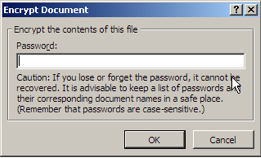Word processing/Working with documents/File management
| Word processing | |
|---|---|
| Working with documents | Introduction | File management | Printing | Document types | Key points | Assessment |
Although the concepts are similar, the details of file management procedures differ depending on the version of Windows that you are using. An excellent set of tutorials can be found at gclearnfree.org - check out what's available for your own version of Windows.
Contents
Searching for files and folders
It's important to be able to find a file by searching for it by name or by keywords in the contents of the file.
|
Please note: the following tutorials will open in a new window/tab. When you have finished, simply close the window/tab and you'll return to this page.
|
Passwords
Passwords can be used to prevent others from opening a file, as you are required to enter a password in order to open the file.
If you assign a password to a file you must enter the password each time you open the file. Passwords can contain up to 255 characters and can be made up of letters, numbers, spaces and symbols.
Passwords in Word 2007
- Open a file which you have created
- Click on the Microsoft Office Button
- Click Prepare
- Click Encrypt Document
- Type your password in the Encrypt Document dialog box, then click OK

- Re-enter your password in the Confirm Password dialog box, click OK
Passwords in Word 2010
- Open a file which you have created
- Click on the File Button
- Click Protect Document
- Click Encrypt With Password
- Type your password in the Encrypt Document dialog box, then click OK
- Re-enter your password in the Confirm Password dialog box, click OK
Password exercise
Renaming and deleting folders and files
When you rename a file or folder, it does not make a copy of them. The contents of the file or folder do not change, only the name of the file or folder. You need to be careful when renaming files that you do not change the extension E.g. .docx must stay or the computer will not know what program to use to open the file.
|
Please note: the following tutorial will open in a new window/tab. When you have finished, simply close the window/tab and you'll return to this page.
|
Backups
What is a backup?
Back-up is the computer term meaning to make a copy of any data files which have been created.
How do I make a backup?
Use My Computer, Copy, and Paste to keep a backup copy of Files or Folders (files and folders stay the same, and can be copied onto another storage device easily and used immediately). This could be done on:
- an external hard drive
- a USB – Removable Storage Device
- a CD or DVD if you had a CD or DVD writer
Using Copy and Paste to Backup a File or Folder:
Now you need to go to the location you want to store (paste) your backup copy: we will use the Desktop, but you could also use a USB drive
Repeat the Backup steps, this time backing up a file (eg Words) not a folder.
|
When do I backup my programs and data?
You should back-up regularly depending on how often you enter data.
For example:
- For daily data entry: at the end of the day, end of the week, end of the month and end of the year (often done at night)
- For weekly data entry at the end of week, end of the month, end of the year
- For monthly data entry at the end of each month and end of the year
- Some businesses will back up only data that has changed during the day e.g. Bank Accounts
What do I do with the backups?
Keep backups securely off site in a fireproof environment which has no heat, no moisture, no magnetic interference. This is so that the data is not corrupted by heat, moisture, magnetic interference. Data is kept off site in case of natural disaster.
Backup and restore
The Backup and Restore function within Windows XP, 7 & 8 creates copies of your most important personal files for safety purposes, which you can restore if the worst comes to the worst. See more information about Backup and Restore on the Microsoft website.

